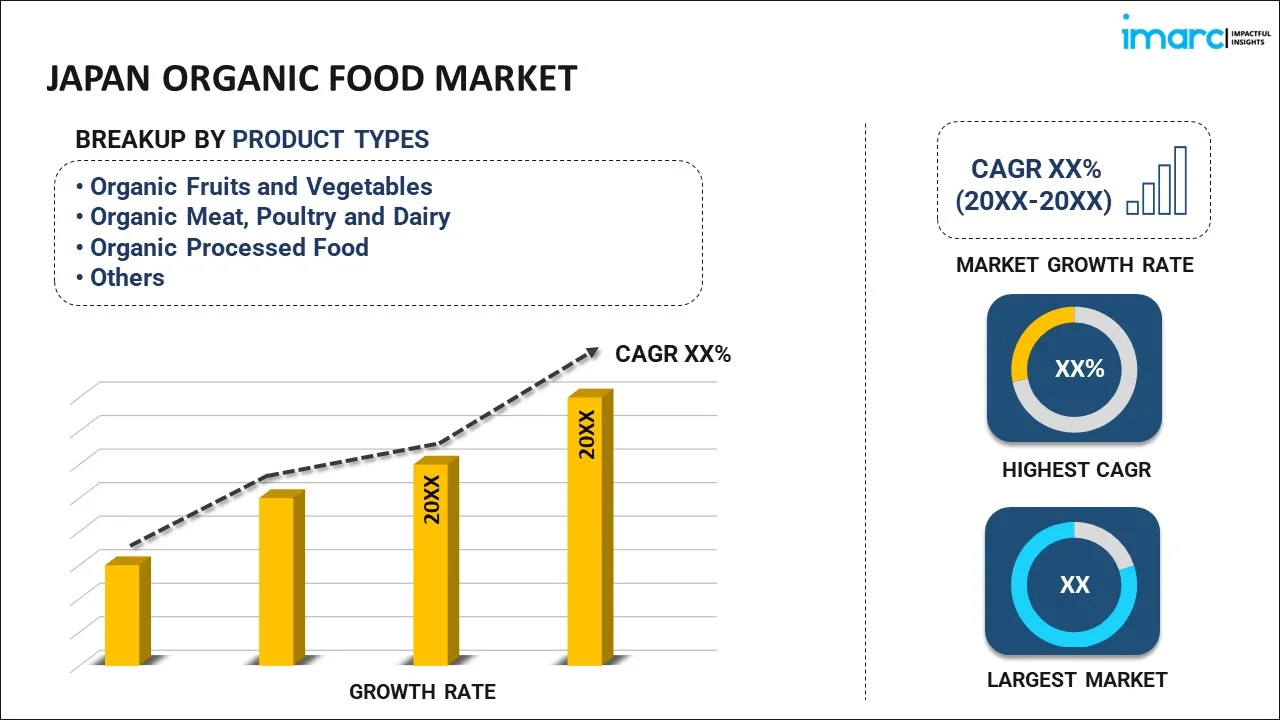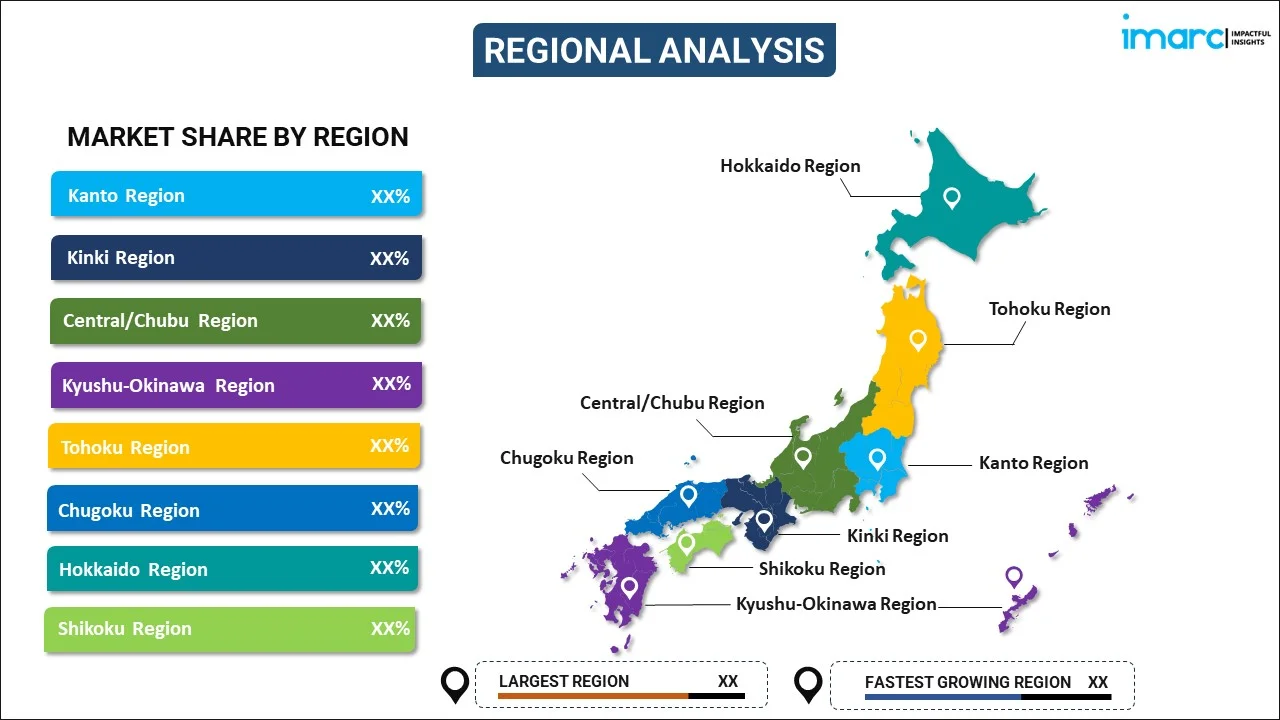
Japan Organic Food Market Report by Product Type (Organic Fruits and Vegetables, Organic Meat, Poultry and Dairy, Organic Processed Food, Organic Bread and Bakery, Organic Beverages, Organic Cereal and Food Grains, and Others), Distribution Channel (Supermarkets and Hypermarkets, Specialty Stores, Convenience Stores, Online Stores, and Others), Application (Bakery and Confectionery, Ready-to-Eat Food Products, Breakfast Cereals, and Others), and Region 2025-2033
Market Overview:
The Japan organic food market size reached USD 1.7 Billion in 2024. Looking forward, IMARC Group expects the market to reach USD 3.9 Billion by 2033, exhibiting a growth rate (CAGR) of 9.7% during 2025-2033. The rising health awareness among the masses, the implementation of stringent Japanese Agricultural Standards (JAS), favorable government support, increasing emphasis on eco-friendly practices, and ongoing technological innovations in farming represent some of the key factors driving the market.
|
Report Attribute
|
Key Statistics
|
|---|---|
|
Base Year
|
2024 |
|
Forecast Years
|
2025-2033 |
|
Historical Years
|
2019-2024
|
| Market Size in 2024 | USD 1.7 Billion |
| Market Forecast in 2033 | USD 3.9 Billion |
| Market Growth Rate (2025-2033) | 9.7% |
Organic food refers to products cultivated and processed without synthetic fertilizers, pesticides, genetically modified organisms, or other artificial chemicals. It emphasizes the use of natural farming methods that foster sustainability and protect the environment. The process begins with the soil, where natural compost and manure are used to nourish the crops, while biological pest control methods replace harmful chemicals. Animals raised organically are given organic feed and ample outdoor access, promoting their well-being. The result is a product often perceived to be fresher, more nutritious, and free from chemical residues. Organic food supports ecological balance and encourages responsible land stewardship. In Japan, organic food is more than a dietary preference; it reflects a cultural shift toward healthier and more sustainable living. Organic products in Japan comply with stringent regulations, ensuring they are free from synthetic fertilizers, pesticides, and other harmful chemicals. These standards extend to every production stage, from farming and processing to packaging and labeling. In recent years, organic food has gained immense popularity across Japan, signifying a broader societal commitment to health, environment, and quality.
Japan Organic Food Market Trends:
The Japanese organic food market is primarily driven by the growing consumer awareness about the health and environmental benefits of organic products. Japanese consumers are increasingly seeking transparency in their food sourcing, desiring products free from artificial chemicals and genetically modified ingredients. Moreover, favorable government initiatives and regulations supporting organic farming are further fostering the Japan organic food market growth. For instance, the implementation of the Japanese Agricultural Standards (JAS) for organic products ensures quality and authenticity, enhancing consumer trust. Besides this, the aging population in the country is influencing a substantial shift toward healthier eating habits, which in turn has catalyzed the demand for organic food. Additionally, domestic producers are heavily investing in organic farming methods, aligning with global sustainability goals, and catering to the consumer preference for locally sourced products. In line with this, the rapid expansion of retail channels specializing in organic products offers consumers greater accessibility and choice, thus propelling market growth. Furthermore, national campaigns promoting organic farming and consumption are building momentum, fueled by collaborations between governmental bodies, NGOs, and private sector stakeholders. Tourism is also playing a vital role, with visitors seeking authentic and traditional food experiences, thereby fueling the demand for organic and locally-sourced products. Along with this, corporate social responsibility (CSR) initiatives by major food companies align with sustainable and organic practices, contributing to market growth. Besides this, the export of Japanese organic products to other Asian markets and beyond is creating new opportunities and widening the market scope. This, coupled with various educational efforts, such as workshops, seminars, and certifications on organic farming, to empower and connect farmers, is expected to stimulate market growth.
Japan Organic Food Market Segmentation:
IMARC Group provides an analysis of the key trends in each segment of the Japan organic food market report, along with forecasts at the country level for 2025-2033. Our report has categorized the market based on product type, distribution channel, and application.
Product Type Insights:

- Organic Fruits and Vegetables
- Organic Meat, Poultry and Dairy
- Organic Processed Food
- Organic Bread and Bakery
- Organic Beverages
- Organic Cereal and Food Grains
- Others
The report has provided a detailed breakup and analysis of the market based on the product type. This includes organic fruits and vegetables, organic meat, poultry and dairy, organic processed food, organic bread and bakery, organic beverages, organic cereal and food grains, and others.
Distribution Channel Insights:
- Supermarkets and Hypermarkets
- Specialty Stores
- Convenience Stores
- Online Stores
- Others
A detailed breakup and analysis of the market based on the distribution channel has also been provided in the report. This includes supermarkets and hypermarkets, specialty stores, convenience stores, online stores, and others.
Application Insights:
- Bakery and Confectionery
- Ready-to-Eat Food Products
- Breakfast Cereals
- Others
The report has provided a detailed breakup and analysis of the market based on the application. This includes bakery and confectionery, ready-to-eat food products, breakfast cereals, and others.
Regional Insights:

- Kanto Region
- Kinki Region
- Central/ Chubu Region
- Kyushu-Okinawa Region
- Tohoku Region
- Chugoku Region
- Hokkaido Region
- Shikoku Region
The report has also provided a comprehensive analysis of all the major regional markets, which include Kanto region, Kinki region, Central/ Chubu region, Kyushu-Okinawa region, Tohoku region, Chugoku region, Hokkaido region, and Shikoku region.
Competitive Landscape:
The report has also provided a comprehensive Japan organic food market analysis of the competitive landscape in the market. Competitive analysis such as market structure, key player positioning, top winning strategies, competitive dashboard, and company evaluation quadrant has been covered in the report. Also, detailed profiles of all major companies have been provided.
Japan Organic Food Market Report Coverage:
| Report Features | Details |
|---|---|
| Base Year of the Analysis | 2024 |
| Historical Period | 2019-2024 |
| Forecast Period | 2025-2033 |
| Units | Billion USD |
| Scope of the Report | Exploration of Historical and Forecast Trends, Industry Catalysts and Challenges, Segment-Wise Historical and Predictive Market Assessment:
|
| Product Types Covered | Organic Fruits and Vegetables, Organic Meat, Poultry and Dairy, Organic Processed Food, Organic Bread and Bakery, Organic Beverages, Organic Cereal and Food Grains, Others |
| Distribution Channels Covered | Supermarkets and Hypermarkets, Specialty Stores, Convenience Stores, Online Stores, Others |
| Applications Covered | Bakery and Confectionery, Ready-to-Eat Food Products, Breakfast Cereals, Others |
| Regions Covered | Kanto Region, Kinki Region, Central/ Chubu Region, Kyushu-Okinawa Region, Tohoku Region, Chugoku Region, Hokkaido Region, Shikoku Region |
| Customization Scope | 10% Free Customization |
| Post-Sale Analyst Support | 10-12 Weeks |
| Delivery Format | PDF and Excel through Email (We can also provide the editable version of the report in PPT/Word format on special request) |
Key Questions Answered in This Report:
- How has the Japan organic food market performed so far and how will it perform in the coming years?
- What has been the impact of COVID-19 on the Japan organic food market?
- What is the breakup of the Japan organic food market on the basis of product type?
- What is the breakup of the Japan organic food market on the basis of distribution channel?
- What is the breakup of the Japan organic food market on the basis of application?
- What are the various stages in the value chain of the Japan organic food market?
- What are the key driving factors and challenges in the Japan organic food market?
- What is the structure of the Japan organic food market and who are the key players?
- What is the degree of competition in the Japan organic food market?
Key Benefits for Stakeholders:
- IMARC’s report offers a comprehensive quantitative analysis of various market segments, historical and current market trends, market forecasts, and dynamics of the organic food market in Japan from 2019-2033.
- The research study provides the latest information on the market drivers, challenges, and opportunities in the Japan organic food market.
- Porter's five forces analysis assist stakeholders in assessing the impact of new entrants, competitive rivalry, supplier power, buyer power, and the threat of substitution. It helps stakeholders to analyze the level of competition within the Japan organic food industry and its attractiveness.
- Competitive landscape allows stakeholders to understand their competitive environment and provides an insight into the current positions of key players in the market.
Need more help?
- Speak to our experienced analysts for insights on the current market scenarios.
- Include additional segments and countries to customize the report as per your requirement.
- Gain an unparalleled competitive advantage in your domain by understanding how to utilize the report and positively impacting your operations and revenue.
- For further assistance, please connect with our analysts.
 Request Customization
Request Customization
 Speak to an Analyst
Speak to an Analyst
 Request Brochure
Request Brochure
 Inquire Before Buying
Inquire Before Buying




.webp)




.webp)












